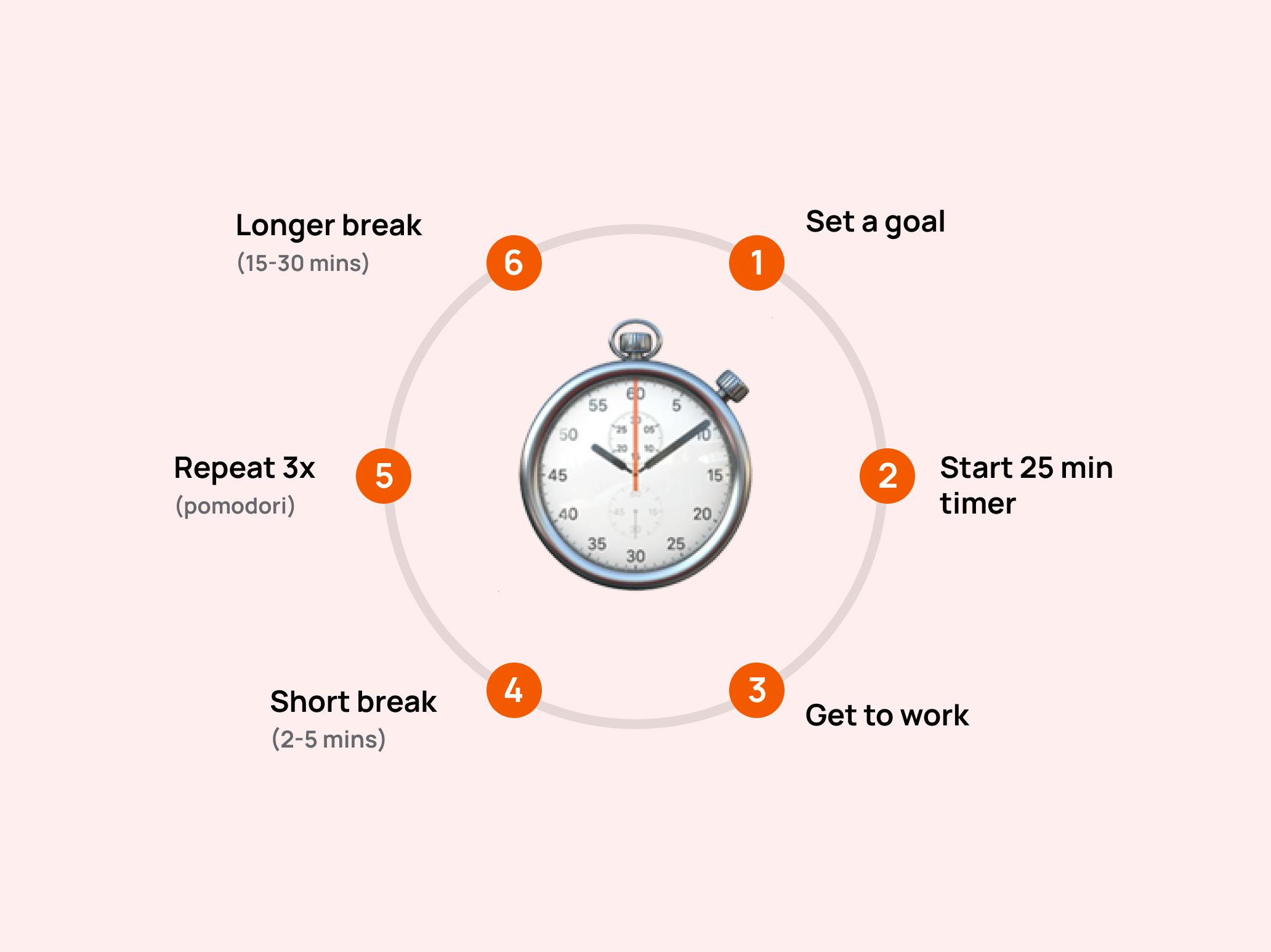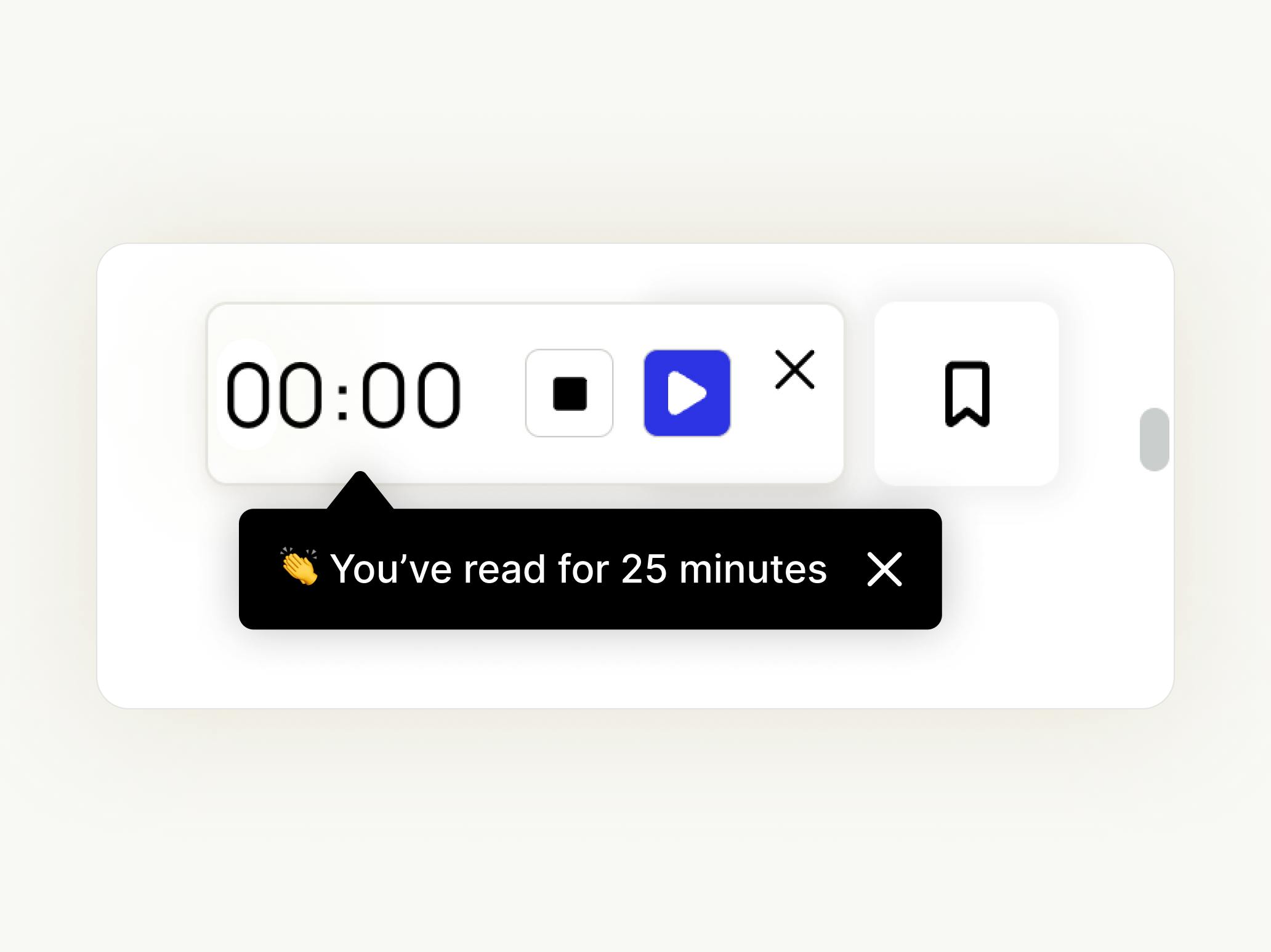The Pomodoro Technique
What do tomatoes and time management have in common? The Pomodoro Technique!
The Pomodoro Technique is a time management tool designed to help you be more productive and less distracted as you work. It was developed in the late 1980s by Francesco Cirillo, then a university student struggling to focus on his assignments. He made a bet with himself that he could work without stopping for a short amount of time and set a kitchen timer, shaped like a tomato (‘pomodoro’ in Italian). When the timer rang, the Pomodoro Technique was born.

The Pomodoro Technique can help you:
- focus more on your work
- accomplish more in less time
- set (and reach!) realistic goals
- break down an open-ended task into manageable chunks
- work smarter, not longer
- make accomplishing tasks feel like a game
- have a better sense of precisely how much work you’ve done in a day
How does it work?
Although Cirillo has developed a whole system based on the Pomodoro Technique and written a full book about it, the method is effective because it is so simple.
The basic elements of this technique are as follows:
- Set a goal.
- Set a timer for 25 minutes.
- Work until the timer goes off. Record what you accomplished.
- Take a short break (2–5 minutes).
- Repeat for three more sessions (pomodori).
- After four pomodori, take a longer break (15–30 minutes).

That’s it! You can string together as many pomodori as you want, working for as much time as you have allotted or until you’ve accomplished a larger goal. The built-in breaks ensure that you can keep up the pace for a long time.
The Pomodoro Technique also includes three rules to get the most out of your work session:
- Break down big projects. If a task requires more than four pomodori to accomplish, break it down into smaller chunks. You’ll more easily track your progress and stay on task within each pomodoro.
- Combine small tasks. If a task requires less than one pomodoro to accomplish, combine it with other smaller tasks. You want to work for the full 25-minute pomodoro.
- Don’t break the pomodoro. Once you’ve set the timer, you must work until the end of it. Don’t let yourself break to check your email or texts; anything that comes up can be addressed when you’re on break (in less than 25 minutes!). And stick to the task you’ve set out for yourself. Other ideas that arise should be written down but addressed during another pomodoro.
undefined
Pomodoro & Perlego
Perlego has the tools to make using the Pomodoro Technique as simple as possible. Using Perlego’s timer feature, you can easily integrate the Pomodoro Technique into your work session.
Perlego’s timer is not only convenient, but it helps you avoid distractions. Using your phone as a timer invites interruptions: each time you check the time or reset the clock, you’ll see notifications popping up and be tempted to do something else on your phone. Perlego’s timer tool helps you focus on the task at hand and save checking your phone for the break.
How to use the timer on Perlego:
- Open up a book.
- Click on the clock icon in the upper righthand corner of your screen.
- Enter the time for one pomodoro (25:00).
- Work until the time runs out; a banner notification will let you know when you’ve finished.
- Click on “restart timer” in the notification to automatically reset the timer for 25:00, or change the time to your short/long rest.

Why does it work?
The Pomodoro Technique is one of the most popular time management methods because it works so well. Here’s what makes it so effective:
It’s SIMPLE. The Pomodoro Technique is easy to remember and follow. You’re more likely to actually use a tool you can remember.
It MAKES WORK A GAME. When Cirillo talks about creating the Pomodoro Technique, he describes making a bet with himself. Each pomodoro is a game: will you outlast the clock? Challenge yourself to see how much you can accomplish in 25 minutes. The more you use the Pomodoro Technique, the more strategic, and speedy, you’ll be.
It HELPS YOU START. By dividing your work into smaller chunks, and setting reasonable goals for each work period, you help tackle the fear of getting started — especially when you’re working toward a larger goal or doing work with no set end (studying for an exam, researching an essay, etc.). The Pomodoro Technique helps you take the first step by making it reachable.
It KEEPS YOU FOCUSED. Distractions are everywhere these days, and we’re all susceptible to them. We tell ourselves “it won’t take that long” or “this reply can’t wait,” and soon we find that we’ve done anything but make progress on our task for the day. The Pomodoro Technique keeps you committed. You’re less likely to find yourself scrolling through Instagram instead of doing your homework if you commit to a 25-minute, distraction-free sprint, knowing that you’ll get a short break very soon.
It SHOWS WHERE YOUR TIME GOES. Have you ever sat down for dinner and thought: what did I even do today? You might have felt like you were working the whole day, but then you look back and don’t feel like you have much to show for it. Dividing your work into pomodori allows you to see how much time it actually takes to accomplish certain tasks and allows you to identify exactly what you spent time on in a given day.
Other tips
Ready to start using the Pomodoro Technique? Here are out last bits of advice for making the most of this method:
- Plan your day in pomodori. Before starting to work, take a look at everything you want to accomplish and break it down into pomodori. Determine how long it will take to accomplish each task and set your priorities so you know exactly what to focus on during each pomodoro.
- Budget overflow sessions. Inevitably, there will be tasks which take longer than you predict or unavoidable interruptions to your day. Build in some cushion pomodori for overflow work that needs more time.
- Set reasonable goals. You can only accomplish so much in 25 minutes. Set yourself a task you can actually achieve during that time. Breaking down large or complex tasks into these reasonable chunks makes them less intimidating and you more productive.
- Experiment with the length of pomodori. For certain kinds of work or types of people, a 25-minute pomodoro might feel too short to really get into your work groove. Try working for 50 minutes with a 10–15 minute break, or even a full 90 minutes with a 20–30 minute break. Other times, you might only be able to get yourself to focus for 10 or 15 minutes at a time on a given day, or you might have a lot of smaller tasks that will only take shorter chunks of time. Experiment with shorter pomodoros and more frequent short breaks. Find what works for you.
- Plan your breaks — and vary what you do. Short breaks are often the perfect amount of time to check the emails and texts you were ignoring while working during your pomodoro. But try to get away from screens for a bit during your breaks as well. Instead of doom scrolling during a short break, grab a snack, make yourself tea, or stand up to stretch your legs. During the longer breaks, go for a walk, do a short workout, or make lunch.
Now, you have all the tools to start using the Pomodoro Technique during your next work session. May the power of the tomato be with you!
MSt, Women's, Gender & Sexuality Studies (University of Oxford)
Paige Elizabeth Allen has a Master’s degree in Women’s, Gender, and Sexuality Studies from the University of Oxford and a Bachelor’s degree in English from Princeton University. Her research interests include monstrosity, the Gothic tradition, illness in literature and culture, and musical theatre. Her dissertation examined sentient haunted houses through the lenses of posthumanism and queer theory.
